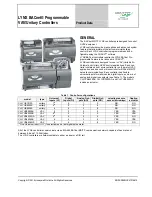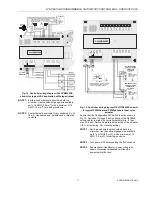
LYNX BACNET PROGRAMMABLE, VAV/UNITARY CONTROLLERS – PRODUCT DATA
EN0Z-0959GE51 R0615
6
NOTE 1:
If controllers are mounted in unusually dusty or
dirty environments, an inline, 5-micron disposable
air filter (use 5-micron filters compatible with
pneumatic controls) is recommended for the high-
pressure line (marked as +) connected to the air
flow pickup.
NOTE 2:
The tubing from the air flow pickup to the controller
should not exceed 1 m. Any length greater than
this will degrade the flow sensing accuracy.
NOTE 3:
Use caution when removing tubing from a con-
nector. Always pull straight away from the con-
nector or use diagonal cutters to cut the edge of
the tubing attached to the connector. Never
remove by pulling at an angle.
1 2 3 4 5 6 7 8 9 0 1
2 2 2 2 2 2 2 2 2 2 3
NS- and AS-models
P
AIR FLOW
PICK-UP
RESTRICTOR
PORTS
Fig. 8. Air flow pick-up connections
Power
Before wiring the controller, determine the input and output
device requirements for each controller used in the system.
Select input and output devices compatible with the controller
and the application. Consider the operating range, wiring
requirements, and the environment conditions when selecting
input/output devices. When selecting actuators for modulating
applications, consider using floating control. In direct digital
control applications, floating actuators will generally provide
control action equal to or better than an analog input actuator
for lower cost.
Determine the location of controllers, sensors, actuators, and
other input/output devices and create wiring diagrams. See
Fig. 14 through Fig. 20 for typical controller wiring con-
figurations.
The application engineer must review the control job require-
ments. This includes the sequences of operation for the con-
troller, and for the system as a whole. Usually, there are
variables that must be passed between the controller and
other controllers that are required for optimum system wide
operation. Typical examples include the outdoor air tem-
perature, the demand limit control signal, and the smoke
control mode signal.
It is important to understand these interrelationships early in
the job engineering process, to ensure proper implementation
when configuring the controllers. See the controller
Application Guides.
Power Budget
A power budget must be calculated for each device to deter-
mine the required transformer size for proper operation. A
power budget is simply the sum of the max. power draw
ratings (in VA) of all the devices to be controlled. This
includes the controller itself and any devices powered from
the controller, such as equipment actuators and various
contactors and transducers.
IMPORTANT
When multiple controllers operate from a single
transformer, connect the same side of the transformer
secondary to the same power input terminal in each
device. The earth ground terminal (terminal 3) must be
connected to a verified earth ground for each controller
in the group (see Fig. 10).
Half-wave devices and full-wave devices must not use
the same AC transformer. If a LYNX controller is to
share its power supply with another device, make sure
the other device utilizes a half-wave rectifier and that
the polarity of the wiring is maintained.
Wiring
All wiring must comply with applicable electrical codes and
ordinances, or as specified on installation wiring diagrams.
Controller wiring is terminated to the screw terminal blocks
located on the top and the bottom of the device.
WARNING
Electrical Shock Hazard.
Can cause severe injury, death or property
damage.
To prevent electrical shock or equipment damage,
disconnect power supply before beginning wiring or
making wiring connections.
NOTE 1:
For multiple controllers operating from a single
transformer, the same side of the transformer
secondary must be connected to the same power
input terminal in each controller. Controller con-
figurations will not necessarily be limited to three
devices, but the total power draw, including
accessories, cannot exceed 100 VA when powered
by the same transformer (U.S., only). For power
and wiring recommendations, See section “Power”
on page 6. The earth ground terminal (terminal 3)
must be connected to a verified earth ground for
each controller in the group (see Fig. 10).
NOTE 2:
All loads on the controller must be powered by the
same transformer powering the controller itself. A
controller can use separate transformers for con-
troller power and output power.


































